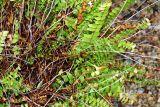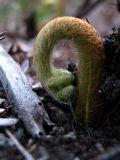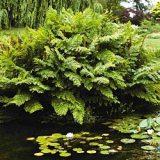Ferns
Ferns are invariably found growing in moist, shaded, fairly undisturbed spots and in cracks in rocks. Wild ferns are such pretty and interesting plants that they make a good study. Fern "leaves" are referred to as fronds. The fronds of some fern species are composed of a single blade, while other species have their blades divided into smaller sections, and sometimes even those sections can be divided, and divided again. Instead of calling those subdivisions "leaflets," as we do when talking about leaves, when dealing with ferns we call them pinnae (pronounced PIN-EE; the singular is pinna, pronounced PIN-uh). In many fern species the pinna is divided into subdivisions known as pinnules. The "midrib" of a frond is dark and is referred to as the rachis (pronounced RAY-kiss). The short "stem" at the frond's base is known as the stipe.
In a home garden, the community park or the office space ferns are always look beautiful. Ferns are popular because of their graceful foliage and ability to grow in low light. Many different types of ferns can be grown indoors for interior decoration.
Height/Spread
Ferns come in very small size of not more than 6 inches tall and these are best suited for growing
in the home garden (indoors) or the office space. Some of the larger ferns may grow up to a
5-foot tall when mature and as such are suitable only for outdoor growing.
The ferns are selected as a garden plant because of their graceful foliage and growing habit. The most commonly grown ferns have finely cut leaves called fronds; there are many other foliage types. Holly ferns have fronds with broad segments that are leathery, shiny and toothed leaves. Several other ferns have fronds that are not divided at all. Staghorn ferns foliage is deeply lobed and resembles the antlers of a stag.
Some ferns are also grown for their unusual stems that creep along the soil surface. These rhizomes are covered with brown or tan hairs that make them look like the feet of animals.
Culture
Every variety of the ferns has in their individual growing condition and fertiliser needs. Some commonly grown indoor ferns have a reputation for being fussy, but others are surprisingly easy to grow. The ferns with tough, leathery foliage usually adapt better to typical household conditions than feathery, delicate types. The more delicate types of ferns will grow best with special care.
Most ferns prefer moderate, indirect light inside. Close to a north-facing window is ideal. Never put ferns directly in a south or west-facing window. Direct sunlight will damage the foliage.
The ideal temperature range for most ferns is between 15 to 20 °C during the day and about 5 °C at night. All ferns are moisture lovers, but the amount that they need varies among the many different types of ferns. Some ferns like to be kept almost wet while others should be kept slightly dry between each water application. Be sure not to allow any of them to dry out completely. Do not allow water to stand in pots since this can lead to root rot.
The potting soil for ferns should be porous and in order to allow excess water to drain fast. The ferns grow best in an organic, humus rich soil that is evenly moist and slightly acidic soil.
Potting medium similar to the soils in their natural growing habitats. Humidity
is necessary for the healthy growth of the ferns and it has to be maintained because it usually very low indoors is it home or the office. The best method is to use mist spray at least once a day.
Most ferns should be fertilsed lightly once a month from April through September. Liquid houseplant fertilisers should be applied at about one-half the recommended rate. The leafs of the ferns will get burnt in case of heavy dose of fertilizer application. During winters ferns do not require any fertilisers it should be noted that nor fertilisers are applied to fresh potted or repotted ferns for six months.
Propagation
The ferns do not have flowers and reproduce with spores, which are so small you can hardly see them with the naked eye. When the spores are mature these are carried by the wind to a new location where, if environmental conditions are right, they germinate to form fern prothalli, from which eventually new ferns will emerge.
In the home garden the best method of propagating most ferns is by division. Repot overcrowded plants in early spring, using a mixture of equal parts of garden soil and river sand mixed with peat moss or leaf mold.
Pests and Diseases
In the home garden, plant diseases are very rare. Too much or too little water plus insects and mites are the main problems. Root rot usually results from a soil mix that does not drain fast or because of excess water application.
The most common insect problems are scale insects and mites. Pesticide sprays may injure many ferns. Read the label of any control product carefully, test the spray on a small area or number of plants first, and observe for injury. Insects can often be removed by hand picking or by a brisk water spray outside.
Ferns may develop brown leaves or leaflets at low humidity. This is especially common on ferns with thin, delicate fronds, such as maidenhairs.
Suggested Ferns for the
|
Common Name/ |
Size (Height/Spread) |
Growing Conditions |
Description |
|
Maidenhair Fern (Adiantum tenerum) |
20 to 50 cm tall |
Since they grow best in low light the right place is to place then is near a window facing the north. Day temperatures of 15 to 20 °C and night temperatures of 15 °C. High humidity of about 50 percent is needed. Keep the soil moist at all times. |
Maidenhair ferns are graceful and delicate in appearance, with tiny leaflets cascading along black wirelike stems. The fan maidenhair has fan-shaped leaflets, which sometimes overlap. |
|
Birds Nest Fern |
Grows to 25 cm tall |
Since they grow best in low light the right place is to place then is near a window facing the north. Keep the soil moist. Ideal temperatures are from 15 to 20 °C. |
Broad, soft green, undivided fronds are arranged in a vase shape. |
|
Squirrel's Foot Fern |
30 to 40 cm tall. |
Since they grow best in low light the right place is to place then is near a window facing the north. The recommended day and night temperature is 15 to 30 °C... Keep moist at all times. |
Creeping rhizomes that are soft and furry extend over the edge of the container. These ferns are well-suited to hanging baskets. The dark green fronds are feathery. |
|
Sword Fern |
25 to 30 cm. Some cultivar can grow up to 100 cm. |
They grow best in bright indirect or filtered sunlight. The recommended night and day temperatures of 15 to 20 °C. Keep the soil barely moist at all times. Needs high humidity to thrive. Can be affected by spider mites, scale insects and mealybugs. |
These have arching fronds up to 100 cm long that cascade on all sides. |
|
Staghorn Fern |
100 cm or more in length and width |
Bright indirect or filtered sunlight. The recommended day and night temperatures of 15 to 25 °C. Keep the soil moist at all times. Staghorns need very high humidity. |
The plant has two kinds of fronds. Large gray green antler-shaped fronds hang down. |
|
Rabbit's Foot Fern |
60 to 90 cm long. |
They grow best in bright indirect or filtered sunlight. The recommended night and day temperatures of 15 to 20 °C. Keep the soil light moist. |
Leathery fronds rise above thick, furry creeping stems called rhizomes. |
|
Crested Spider Brake Fern |
15 to 20 cm tall |
Bright indirect or filtered sunlight. The recommended day and night temperatures of15 to 20 °C. Keep the soil light moist. |
Cristata’ has dense dark green fronds with long slender leaflets that end in frilly crests. |
|
Ostrich Fern (Matteuccia struthiopteris) |
30 to 40 cm / 45 cm |
Shade/Partial Shade. indirect or filtered sunlight. The recommended day and night temperatures of 15 to 20 °C. Keep the soil light moist. |
Medium green, finely dissected leaves. Fronds are shaped like tail feathers of a bird. Nice, rich green accent for a shaded garden or background to other low growing shade perennials. |
|
Japnese Fern (Athyrium niponicum var. pictum) |
15 to 40 cm / 70 -90 cm |
|
Fine, lovely gray green foliage. Known for its silver gray foliage with purple-red veins and stems with a weeping habit. The color is stronger with some light sun. Fine leaf texture. Deciduous. |
|
Lady Fern (Athyrium filix-femina) |
60 to 90 cm / 30 to 60 cm |
Shade/Partial Shade.Day and night temperatures of15 to 20 °C. Keep the soil light moist. |
A beautiful, elegant fern that performs gracefully in shady gardens or woodland settings. Plant several for a groundcover effect in a shaded area. Cut a frond or two to add to a cut flower arrangement for a lovely green background. |
|
Royal Fern (Lilium) |
5 to 10 cm / 20 to 30 cm |
Partial Shade/Full Sun; Day and night temperatures of15 to 20 °C. Keep the soil light moist. |
ferns also flower with regular Lily shaped flowers, Trumpet shaped and flowers with reserved petals. |




